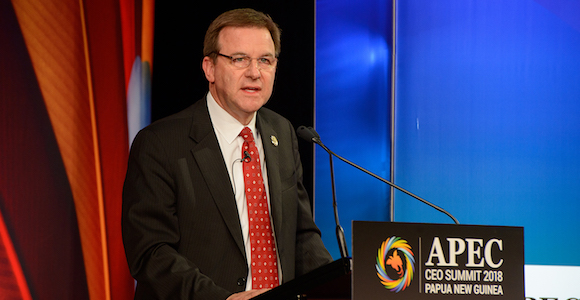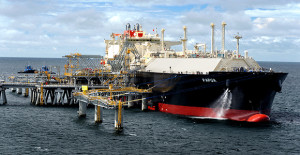Neil Chapman, Senior Vice President of ExxonMobil, told the APEC CEO Summit earlier this month that LNG capacity in Papua New Guinea could double. He claimed the global shift to natural gas to reduce carbon emissions is favouring the industry.

ExxonMobil’s Neil Chapman. Source: ExxonMobil
Chapman said ExxonMobil is ‘talking with the government about a three-train expansion’ of the PNG LNG plant outside Port Moresby.
‘This will involve several partners and will roughly double LNG capacity from Papua New Guinea.
‘I’m hopeful that, with support of the government, we can come to an agreement on terms soon and together move forward on a new chapter in PNG’s energy story.
‘There’s no question about the appetite for LNG throughout Asia being strong.
‘Every shipload of LNG that sails from Port Moresby represents opportunity and enhanced energy security for the dynamic economies of this region.’
‘The market for increased production is out there.
‘LNG import terminals are being built throughout the region.
Golden Age
Chapman said there is evidence of a ‘Golden Age for gas’, as was foreseen by the International Energy Agency.
PNG, he believes, is ‘well positioned to benefit’ from the burgeoning LNG trade.
But he cautioned that although the country’s resources are ‘abundant’, they are not easily accessible.
‘Every shipload of LNG that sails from Port Moresby represents opportunity and enhanced energy security for the dynamic economies of this region.
‘Over the next couple of decades, about half of the world’s economic expansion is expected to take place right here in Asia.
‘When natural gas is used for electricity generation it produces up to 60 per cent fewer greenhouse gas emissions.’
‘That’s why the International Monetary Fund describes the region as “the main engine of the world’s economy”.
‘Helping fuel that engine will be abundant, cleaner-burning natural gas, some of it shipped from here in Papua New Guinea to the markets throughout Asia-Pacific.’
Environment

The LNG tanker ‘Papua’ loading at the PNG LNG project’s marine terminal. Credit: ExxonMobil/Richard Dellman
Chapman said that when natural gas is used for electricity generation it produces up to 60 per cent fewer greenhouse gas emissions than coal.
‘Substituting natural gas for coal in power generation provides an immediate, large-scale and cost-effective option for making significant progress in lowering the global emissions while improving air quality.’
This can be seen already in the United States, where electric utilities have shifted from coal to lower-cost natural gas.
‘US greenhouse gas emissions have fallen to levels not seen since the 1990s.
That’s not a decrease in the rate of growth of emissions, nor a reduction in per capita emissions—nor any other qualifier or context.
‘It’s an actual decrease in overall emissions to levels not seen for more than two decades.
‘It’s even more extraordinary when you consider it has happened against the background of a growing economy, rising energy production and increased energy use.
‘There’s no reason to believe a similar approach to pursue these sorts of benefits cannot be replicated in Asia-Pacific, and indeed in other parts of the world.’








Speak Your Mind